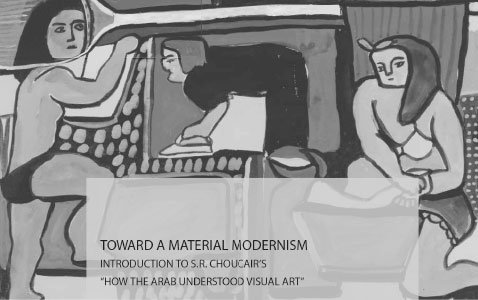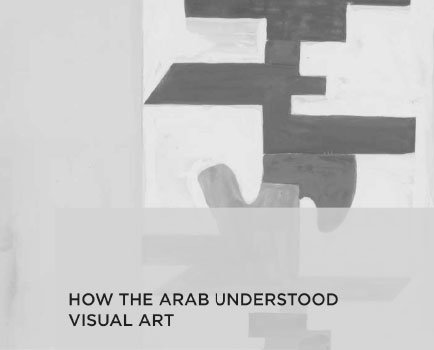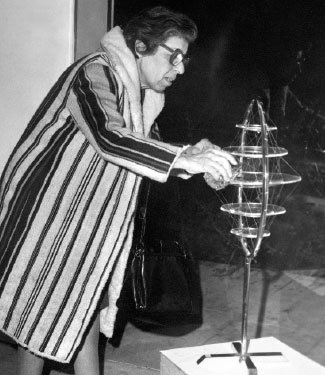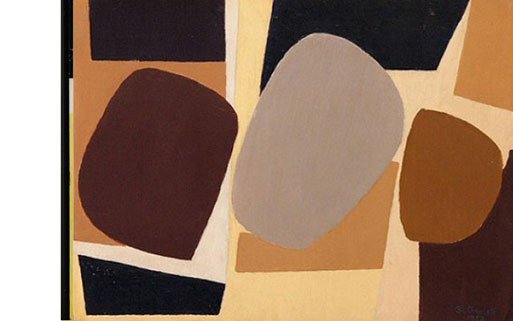articles

Toward a Material Modernism by Kirsten Scheid
“How the Arab Understood Visual Art” was not meant for publication. It originated as a private letter, an angry rebuke between former colleagues in the field of Arab cultural production and the struggle against colonialism and its intellectual aftermath. But mutual friends of the sender, artist Saloua Raouda Choucair, and the recipient, literary critic Musa Sulaiman, read its contents and were so struck by its “innovative ideas and daring, critical perspectives” that they quickly circulated it among the intellectual elite of Beirut, hometown to both Choucair and Sulaiman. Appearing in several versions in the city’s leading cultural journals in the spring of 1951, it metamorphosed into a quasi-manifesto for modernist art. Sixty years later, the letter is consistently cited to support the claim that its author was “the first true abstract modern artist in Lebanon (and perhaps the Arab world),” as a Tate Modern curator says in her essay for Choucair’s recent retrospective. Yet the document is rarely read nowadays. Consequently, its principal characters and concerns have been transformed through retellings, and the complexities it confronted have faded. Tellingly, Choucair’s nuanced discussion of an “Arab perspective” echoes in today’s art-criticism circles as “Islamic art,” a term not found in her letter. And the question of matter and materialism has been reduced to sound bites about naked bodies, or their absence, in Arab representational repertoires.

How the Arab Understood Visual Art by Saloua Raouda Choucair
Having read your book and taken note of your personal opinions, analysis, and interpretation, I am prompted to make a few observations that may be of some benefit, or even much. First, I want to draw your attention to the issue of Orientalists and how they appear from the perspective of us Arabs, or rather from the perspective of you who studied with them and were influenced by their standards. In your various studies of Arabs, their history, and their literature, you compare them to the civilizations that precededthem, whether Indian, Persian, or Greek. I do not believe that such a comparison is fair or tenable, unless we allow comparing Ibnal-Farid with Napoleon, for example.
In your study of the Arabic story, you ventured to note some very strange Arab aesthetics, but the general standards on which you base your study prevented you from declaring them directly, so you gave only a glimpse, and consequently your questions proliferated. I acknowledge that Arabs borrowed much from the peoples they encountered, among them Indians, Persians, and Greeks. Yet, on the other hand, everything they took, they stamped with their own personality.

Pure Visual Art According to Saloua Raouda Choucair by Jack Aswad
From the beginning, that is (as far as Saloua Raouda Choucair can recall of the young school-girl she was in the 1920s), from her very first contact with the age-old reigning concepts about two- and three- dimensional representation, it seemed that the uphill road to an art which increases one’s isolation the more one persists in it, was a road already carved out for her…as if all that was required of this young girl, who had never in her life glimpsed anything like“that” towards which she was striving with her tranquil obstinacy, was simply to hold on to that which pulled her towards it, seeking only to elucidate its obscurity.

A Modernist Explored by Roberta Smith
This sparkling exhibition gives New York its first in-depth look at the wide-ranging activities of Saloua Raouda Choucair, a pioneer of Lebanese modernism who spent four years in Paris after World War II, has worked most of her life in Beirut, and will turn 100 in 2016. It reminds us that modernism proceeds at different speeds not only around the globe but also within the efforts of individual artists.
The 32 works of painting, sculpture, tapestry and design here date from 1947 to 2014. They look variously behind, in step with or ahead of their times. Most prescient is Ms. Choucair’s refusal to distinguish between functioning and nonfunctioning objects. Equally engaging are an infallible feel for materials — especially wood — and scale, and a brilliant fusing of organic and geometric form. Small maquettes succeed as full-fledged works of art.
In Paris, Ms. Choucair (pronounced shoo-CARE) studied with Fernand Léger, and came to admire the architecture of Le Corbusier. She was also inspired by Arabic calligraphy and Arabic poetry, stanzas of which traditionally are often interchangeable. Several pieces involve interlocking forms, whether a terra cotta model for a curving park bench or relatively simple two-part sculptures, some made of fiberglass. The American artists with whom Ms. Choucair’s work connects include Isamu Noguchi, Eva Hesse and Raoul Hague, the Abstract Expressionist carver of wood, as well as the neglected German-born sculptor Ruth Vollmer (1903-1982), who, like Ms. Choucair, was fascinated with science and mathematics.
Despite its size and scope, this exhibition barely scratches the surface of Ms. Choucair’s prolific career, but it’s a welcome start.